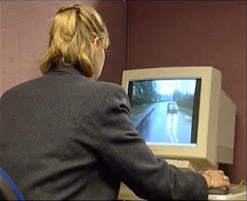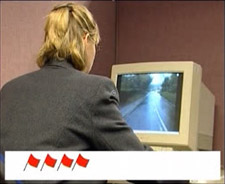About the Hazard Perception Test
The following DVSA introduction video would be played at the start of the Hazard Perception Test. If you wish to watch this video please roll the mouse pointer over the image below and click the play button.
The above video explains how the hazard perception test works and what you are required to do. You would then be shown 14 hazard perception video clips of approximately one minute each. There will be 15 developing hazards to find - at least one on each clip. However, one clip will have 2 developing hazards. The clips will not contain any sound - just like the old silent movies.
 Each clip will start with a freeze frame of the start of the video and a count down from 10 will commence. At the end of the count down the clip will start to play and you will be required to click the mouse each time you see a potential hazard start to develop and each time any additional evidence appears to support that development. To let you know that the program has registered your click a red flag will appear on a grey band across the bottom of the screen - one flag for each click you make in any particular clip. At the end of the clip all the flags will be removed before you start the next clip. Although each clip contains several potential hazards only the one that materialises into a real hazard and involves another road user is marked (i.e. that required the driver to take some form of action to avoid the hazard).
Each clip will start with a freeze frame of the start of the video and a count down from 10 will commence. At the end of the count down the clip will start to play and you will be required to click the mouse each time you see a potential hazard start to develop and each time any additional evidence appears to support that development. To let you know that the program has registered your click a red flag will appear on a grey band across the bottom of the screen - one flag for each click you make in any particular clip. At the end of the clip all the flags will be removed before you start the next clip. Although each clip contains several potential hazards only the one that materialises into a real hazard and involves another road user is marked (i.e. that required the driver to take some form of action to avoid the hazard).
 The score you obtain will be dependant upon how quickly you spot the potential hazard as it materialises and therefore develops. The time from when the potential hazard starts to develop to when the vehicle arrives at the hazard is the time frame or window used to determine your score. This window of time is divided into 5 equal segments. If you click the mouse while in the first segment (i.e. just has the potential hazard starts to materialise) you will obtain the maximum score of 5 points. If you click in the second segment of this window of time you will score 4 points, then 3, then 2 and then in the last segment just 1. This is accurate to one twenty fifth of a second. If you don't click the mouse in this window of time you will score nothing in respect to that hazard. Within the scoring window if you click several times only the first click will be used to determine your score (i.e. the highest scoring click).
The score you obtain will be dependant upon how quickly you spot the potential hazard as it materialises and therefore develops. The time from when the potential hazard starts to develop to when the vehicle arrives at the hazard is the time frame or window used to determine your score. This window of time is divided into 5 equal segments. If you click the mouse while in the first segment (i.e. just has the potential hazard starts to materialise) you will obtain the maximum score of 5 points. If you click in the second segment of this window of time you will score 4 points, then 3, then 2 and then in the last segment just 1. This is accurate to one twenty fifth of a second. If you don't click the mouse in this window of time you will score nothing in respect to that hazard. Within the scoring window if you click several times only the first click will be used to determine your score (i.e. the highest scoring click).

If you try to cheat the system by clicking the button repeatedly the program will pick this up by looking at the number of clicks over the clip as a whole and the pattern of clicks. There is a certain maximum number of clicks permitted per clip but this is believed to be over 20 clicks. The computer program also looks for any pattern of repeated clicking or a short burst of rapid clicks. If this is detected a message window will appear at the end of the clip letting you know that an irregular clicking activity was detected and that as a result the score for that clip will be zero.

The official hazard perception test introduction video clip recommends that you click the mouse button each time you detect a change as the hazard materialises, not just once when you think you have seen it start to develop. This will ensure you score the maximum for each clip even if you click too early as you anticipate a hazard rather than responding to its development. Hence, it would be normal to click 2, 3 or possibly 4 times as the hazard evolves. However, make sure you only click in response to changes you see.
When the clip ends the screen will turn black for a few seconds before the freeze frame for the next video clip appears and the count down commences again warning you to get ready. This pattern is repeated until all 14 video clips have been shown.
At the end of the hazard perception test you will be given the option to complete a customer care survey if you so wish. You will then be directed to leave the room and collect your score for the 2 parts of the exam. The maximum score that can be obtained for the hazard perception part of the theory test is 75 (i.e. 15x5). To pass the hazard perception part of the Car, moped and motorcycle theory test you must obtain a score of 44. To pass the theory test you must pass both parts. If you fail either part you are required to take both parts of the test again.











